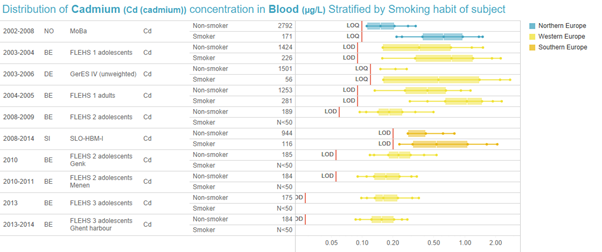
Check the European Human Biomonitoring Dashboard
The new European Human Biomonitoring Dashboard is available online
On 30th March 2021, HBM4EU launched the long-awaited European Human Biomonitoring Dashboard. The Dashboard visualises summary statistics from human biomonitoring data collections from all over Europe, gathered under the HBM4EU project, and is publicly accessible on the HBM4EU website. It makes human biomonitoring data accessible to a broader community, allowing users to explore exposure levels and trends in the exposure of European citizens to chemicals.
The data is focused on HBM4EU priority substances, and were gathered through standardised procedures. For each data collection, the dashboard visualizes the percentiles of biomarker levels (P05, P10, P25, P50, P75, P90, P95) and displays information on the limit of detection (LOD) and/or limit of quantification (LOQ). A filter function allows the user to filter biomarker data by subgroups, such as by gender, age and level of educational. Information included in the dashboard currently covers 62 human biomonitoring data collections from 15 countries produced during the period from 1991 to 2019. The Dashboard will be continuously updated and when HBM4EU draws to a close in June 2022, the data from the aligned studies will be incorporated.
The Dashboard can be used to explore available data, as well as to confirm earlier findings. For instance, observed concentrations of perfluorooctane sulfonic acid (PFOS) in blood (serum/plasma) are generally lower in female compared to male subjects within the same study population. This was already reported in literature, explained by the elimination of PFASs through menstruation, and for mothers also through delivery and lactation [1-9]. This trend can be observed in Figure 1.
Observed concentrations of cadmium in blood are generally higher in smokers compared to non-smokers within the same study population. This association between smoking and higher cadmium levels in blood was already reported in literature [10, 11], and can be observed in Figure 2.
This European Human Biomonitoring Dashboard was developed by the Flemish Institute for Technological Research (VITO). VITO and the whole HBM4EU team gratefully acknowledge the data owners who shared their data, making them widely available for risk assessment and risk management.
If you are interested in integrating aggregated human biomonitoring data from your data collection in the European Human Biomonitoring Dashboard, please contact HBMDASHBOARD@vito.be.
Figure 1: Reported distribution (P05-P10-P25-P50-P75-P90-P95) of PFOS levels in blood (µg/L) in studies in Europe between 2000 and 2019, stratified by sex.
Figure 2: Reported distribution (P05-P10-P25-P50-P75-P90-P95) of blood cadmium levels (µg/L) in studies in Europe between 2002 and 2014, stratifies by smoking behaviour.
- Colles, A., et al., Perfluorinated substances in the Flemish population (Belgium): Levels and determinants of variability in exposure. Chemosphere, 2020. 242: p. 125250.
- Wong, F., et al., Enhanced elimination of perfluorooctane sulfonic acid by menstruating women: evidence from population-based pharmacokinetic modeling. Environ Sci Technol, 2014. 48(15): p. 8807-14.
- Brantsaeter, A.L., et al., Determinants of plasma concentrations of perfluoroalkyl substances in pregnant Norwegian women. Environ Int, 2013. 54: p. 74-84.
- Lien, G.W., et al., Neonatal-maternal factors and perfluoroalkyl substances in cord blood. Chemosphere, 2013. 92(7): p. 843-850.
- Berg, V., et al., Maternal serum concentrations of per- and polyfluoroalkyl substances and their predictors in years with reduced production and use. Environ Int, 2014. 69: p. 58-66.
- Cariou, R., et al., Perfluoroalkyl acid (PFAA) levels and profiles in breast milk, maternal and cord serum of French women and their newborns. Environ Int, 2015. 84: p. 71-81.
- Bjerregaard-Olesen, C., et al., Determinants of serum levels of perfluorinated alkyl acids in Danish pregnant women. Int J Hyg Environ Health, 2016. 219(8): p. 867-875.
- Rylander, C., et al., Dietary predictors and plasma concentrations of perfluorinated compounds in a coastal population from northern Norway. J Environ Public Health, 2009. 2009: p. 268219.
- Jain, R.B., Contribution of diet and other factors to the levels of selected polyfluorinated compounds: data from NHANES 2003-2008. Int J Hyg Environ Health, 2014. 217(1): p. 52-61.
- Adams, S.V. and P.A. Newcomb, Cadmium blood and urine concentrations as measures of exposure: NHANES 1999-2010. J Expo Sci Environ Epidemiol, 2014. 24(2): p. 163-70.
- Brockhaus, A., et al., Levels of cadmium and lead in blood in relation to smoking, sex, occupation, and other factors in an adult population of the FRG. Int Arch Occup Environ Health, 1983. 52(2): p. 167-75.




